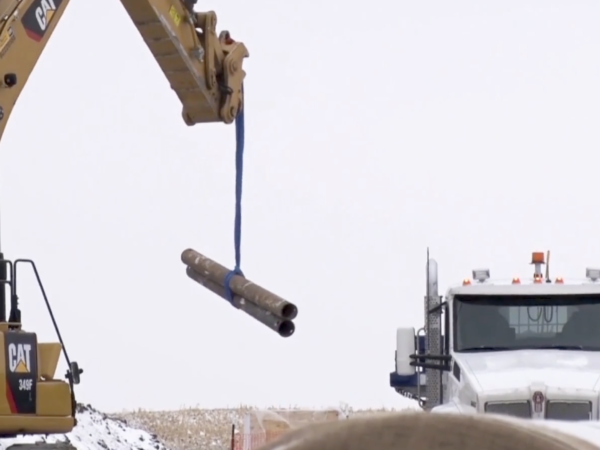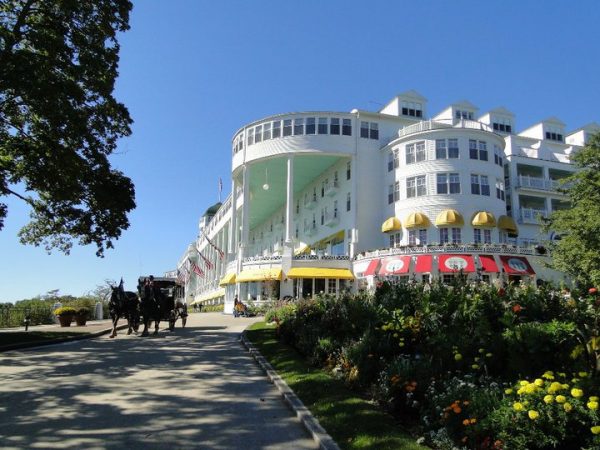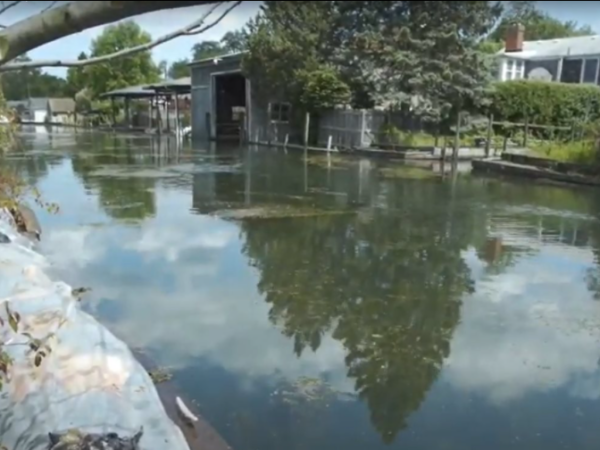
Imagine if the world’s longest trail (located in Canada) connected people even further, into another country, via Michigan’s longest trail. That happened last month when the Windsor Detroit Bridge Authority announced that the Gordie Howe International Bridge would become part of a binational trail system.
When the initial discussions for a potential new bridge connecting Windsor and Detroit started about a decade ago, residents of Windsor and Detroit, and a coalition of organizations, came together to envision cross-border linkages. This coalition developed a U.S.-Canada Greenways Vision Map in 2016 to connect expanding greenways.
This vision map called for bike racks to be added to Windsor-Detroit Tunnel Buses (now complete), a dedicated bicycle and pedestrian lane on the new Gordie Howe International Bridge (under construction), and reinstituting a cross-river ferry that was common before a bridge and tunnel were constructed (not achieved yet).
In response to this 2016 vision map, the Windsor-Detroit Bridge Authority – the Canadian Crown corporation responsible for administering the construction of the Gordie Howe International Bridge – committed to including a dedicated bicycle and pedestrian lane (called a multiuse path) on the new Gordie Howe International Bridge. This bridge is projected to be completed in September 2025.
The $6.4 billion Gordie Howe International Bridge project is the largest and most ambitious binational border infrastructure project along the Canada-U.S. boundary. Once complete, the Gordie Howe International Bridge will be among North America’s top five longest bridges. Its new multi-use path will be toll-free and include one lane that will accommodate two-way pedestrian and cyclist traffic.
On February 9, 2024, the Windsor Detroit Bridge Authority and the Trans Canada Trail – the world’s longest trail that stretches from the Arctic to the Pacific and Atlantic Oceans – announced at a packed Windsor City Hall that the Gordie Howe International Bridge will become the first international bridge border crossing within Trans Canada Trail’s 17,500-mile network. It is a first-of-its-kind partnership that will connect Canadian and U.S. trail systems.
Speaking at the press conference, Windsor Mayor Drew Dilkins said:
“Today marks a big win for tourism and active transportation on both sides of the international border between Canada and the United States. While this trail will certainly be an incredible, scenic route, offering unparalleled views of our two-nation destination, it will also be an economic bridge that will bring our communities closer together.”

Gordie Howe International Bridge becomes part of binational trail system, Feb. 9, 2024 (credit: John Hartig).
Think of this new bridge as the missing link between Detroit’s Joe Louis Greenway, the Detroit RiverWalk, Michigan’s Iron-Belle Trail, Downriver Linked Greenways, and The Great Lakes Way – an interconnected set of greenways and water trails stretching from Port Huron, Michigan to Toledo, Ohio, and Windsor’s greenway trails, Ontario’s Great Lakes Waterfront Trail, and the Trans Canada Trail. The possibilities for cross-border trail tourism will be limitless.
Trail tourism is sometimes called “slow tourism” because it encourages a traveler to relax and engage in local historical, ecological, and cultural experiences. Slowing down in a fast-paced world to experience the natural beauty of a landscape, learn about local history, and celebrate cultural attractions is something that many people are looking for.
One trail tourism adventure might be tracing the footsteps of the more than 30,000 freedom seekers who crossed the Detroit River to gain their freedom in Canada. A bicycle tour could start out visiting Detroit’s Second Baptist Church, listed in the U.S. National Register of Historic Places and which served as a station on the Underground Railroad, and then visit the Underground Railroad monument on the Detroit RiverWalk. From there, the tour could cross the Gordie Howe International Bridge to visit the Sandwich First Baptist Church in Windsor – a national historic site in Canada that welcomed freedom seekers – and then Windsor’s Tower of Freedom, which commemorates the arrival of freedom seekers in Canada.
Another cross-border trail tourism experience could be spending the morning in the crown-jewel park of the Detroit RiverWalk – Ralph C. Wilson, Jr. Centennial Park designed by the world-renowned architectural firm of Michael Van Valkenburgh Associates. This 22-acre park will open in 2025 and feature an outdoor sports house, a playground with multiple animal structures, an expansive lawn for outdoor events, and a nearly two-and-a-half-acre water garden. At the end of a visit to Wilson Park, tourists can jump on a bike, cross the bridge, and experience the 900-acre Ojibway National Urban Park. Ojibway will be Canada’s second national urban park and it too is projected to open in 2025. The park features some of the most diverse vegetation in Canada, including tallgrass prairie, wonderful trails, and a visitor center.
A third cross-border cycling experience could be visiting two birding hotspots on the ByWays to FlyWays birding tour for the Detroit River and western Lake Erie. A morning visit to the 982-acre island park called Belle Isle – designed by famed landscape architect Frederick Law Olmstead – could be the first stop. This urban nature oasis is designated as an “Important Bird Area” by the National Audubon Society. It features waterfowl in the winter, warblers in the spring, egrets, herons, and bald eagles in the summer, and raptors in the fall. After the visit to Belle Isle, next up is crossing the Gordie Howe International Bridge to go birding at Ojibway National Urban Park. With over 240 bird species recorded, it is sure to please. One popular activity for visitors is to put birdseed in the palm of their hands and wait for the birds to come and feed. It is sure to create a sense of wonder.
Benefits of trail tourism include promoting health and wellness, improving quality of life, helping conserve natural resources and protect the environment, celebrating historical preservation and community identity, and stimulating the economy. For example, a Huron Clinton Metropolitan Authority study of southeast Michigan found that parks and trails generate over $90 million in annual economic benefits.
The Michigan Economic Development Corporation estimates that Michigan’s outdoor recreation economy is an economic engine that contributed $12.6 billion, in 2022. Indeed, outdoor recreation, including hiking, trekking, rock climbing, mountain biking, birdwatching, canyoning, rafting, kayaking, and other activities dependent on natural features, has become the most rapidly expanding tourism sector throughout the world.
For those interested in learning more about cross-border trail tourism, the next Canada-U.S. State of the Strait Conference will be held on October 22, 2024 at the University of Windsor.
Catch more news at Great Lakes Now:
Great Lakes Moment: Lest we forget – A history of Detroit River oil pollution
Great Lakes Moment: Ohio provides example for funding Detroit and Rouge rivers’ sediment cleanup
Featured image: Progress in construction of the Gordie Howe International Bridge, February 2024 (credit: Windsor Detroit Bridge Authority).
1 Comment
-
That will be awesome, I hope someday that we here in Northern Ontario can pass through the twin Soos, and hike or cycle down through Mackinac, and cross to Windsor at Detroit, then take the trail, and or the CHI-CHEEMAUN FERRY SERVICE from Tobermory to Manioulin and then on the trail from Espanola back North. Others could pass from Farther West, through Minnesota, Wisconsin, the UP and then south and back again. That would be a good adventure, lots of historic sites and shared history along the way.




